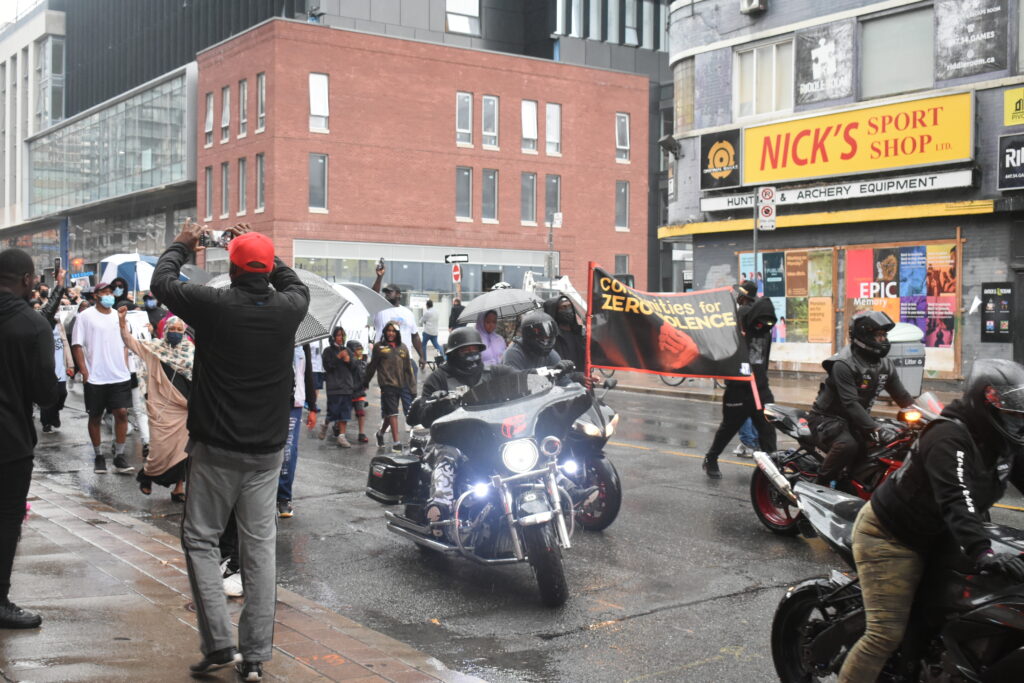
Gun control advocacy groups headed down Yonge Street on Sept. 25, calling for gun policy reform in Toronto and supports for youth at risk.
Advocates participated in the Mothers Peace Walk against gun violence, making their way from Yonge and Bloor to Nathan Phillips Square.
While attendees from different communities agreed on a call to action against gun violence in Toronto, these groups support different approaches to the same issue. Some believe in tighter gun control and a nationwide ban on handguns, citing their use in domestic violence and city crime. Others say enforcement and linked societal issues are the root cause, citing the link between gang violence and racialized poverty.
Evelyn Fox, the founder of Communities for Zero Violence, said she lost her son five years ago to gun violence.
“Canada has one of the strongest gun control legislations in the world, we don’t need more laws,” she said. “The roots of youth violence are poverty. We need to address affordable housing, food security, the education to prison pipeline, structural racism and the ways the systems are run.”
For some attendees, this march was an opportunity for them to grieve the loss of their loved ones.
Brandon Bourque, a Bathurst Street resident, said he attended in remembrance of his friend who was shot outside a Tim Hortons coffee shop in 2016.
“Nikov never got the justice he deserved. There’s a lot of gun control, but there needs to be stricter punishments for violent offenders, and things like illegal (firearm) possession,” Bourque said.
He added that just three weeks ago, he himself was nearly shot in his bedroom when a gunfight erupted outside his home.
Recent legislation, such as the 2020 prohibition on assault-style firearms, has focused on weapons like the AR-15. However, the most common firearms involved in homicides since 1990 have been handguns, according to Statistics Canada.
Additionally, the 2020 Toronto Police Annual Statistics Report showed that of the 663 gun crimes recorded, more than half were committed with a handgun, while rifles represented less than 10 per cent.
Building on the Criminal Code’s magazine capacity restrictions, Bill C-21 proposed numerous amendments to the Criminal Code, Firearms Act and other federal legislation. It also would have criminalized modifications to increase a firearm’s magazine capacity and the sale of replica firearms, such as paintball markers.
Family members and colleagues of the victims of the École Polytechnique and Concordia University shootings wrote a letter criticizing Bill C-21 as “an offensively hollow bill designed by public relations consultants” while not affecting gun owners across Canada. The bill failed to progress beyond the first reading and it effectively died when Parliament was dissolved at the time of the election call.
Bill C-71, meanwhile, extends the firearms licence background check, from five years to the applicant’s life history, and requires private sellers to validate the transfer with the Canadian Firearms Registry.
While Bill C-71, which passed into law in 2019, and Prime Minister Justin Trudeau’s 2020 amendments aim to restrict widespread access to “military-style assault rifles,” Wendy Cukier, president of the Coalition for Gun Control, said these policies target the weapons used in mass shootings in Canada.
However, these bills were not intended to address gun violence in cities: these typically involve illegally or stolen firearms and handguns, not rifles, Cukier said.
Alison Irons is a former RCMP officer and a gun control advocate. Four months ago, her daughter, ended a relationship with a man who then killed her in a murder-suicide.
She said media coverage from several municipalities and provinces came to one consensus: “A national framework is needed. There needs to be a national handgun ban – a municipal or provincial ban would be too expensive and unenforceable,” Irons said.
Claire Smith and Ken Price are members of Danforth Families for Safe Communities, and their daughter was a survivor of the 2018 Danforth shooting.
“The most flawed of all the ideas is micromanaging handgun ownership across Canada’s 3,500 municipalities,” said Price.
“There are too many points of failure; guns are stolen, straw-purchased, and accidents happen. It’s not just about gang use; just last week we charged two people for a straw purchase in Edmonton,” Smith added.
A “straw purchase” occurs when a person who has a clean background and can pass a background check buys a weapon on behalf of someone else.
The 2020 prohibition on assault-style firearms reclassified 1,500 firearms as prohibited, banning their use at target ranges or while hunting. Most of the recently banned firearms were variants and derivatives of the AR-15 rifle.
Functional alternatives to these firearms include civilian versions of the TAR-21, QBZ-95, or the 80-year-old SKS: low recoil, magazine fed, semi-automatic weapons originally designed for front-line combat. Unless modified, these weapons use intermediate cartridges, which typically lack the power for hunting anything bigger than a deer.
As of 2021, these less politicized rifles remain non-restricted, despite having similar origins and function to the AR-15. While the AR-15 is synonymous with the term “assault weapon” after its use in dozens of mass shootings, legislation targeting the AR-15 typically ignores the dozens of hunting and military firearms that are just as dangerous.
Kate was the crime and security reporter with On the Record for the Fall 2021 semester.
